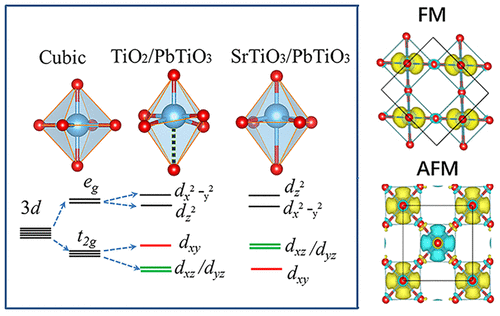当前位置:
X-MOL 学术
›
ACS Appl. Mater. Interfaces
›
论文详情
Our official English website, www.x-mol.net, welcomes your
feedback! (Note: you will need to create a separate account there.)
Tuning Interfacial Magnetic Ordering via Polarization Control in Ferroelectric SrTiO3/PbTiO3 Heterostructure
ACS Applied Materials & Interfaces ( IF 8.3 ) Pub Date : 2018-02-26 00:00:00 , DOI: 10.1021/acsami.7b19112 Yunhao Lu 1 , Fang Wang 1 , Miaogen Chen 2 , Zhenyun Lan 1 , Zhaohui Ren 1 , He Tian 1 , Kesong Yang 3
ACS Applied Materials & Interfaces ( IF 8.3 ) Pub Date : 2018-02-26 00:00:00 , DOI: 10.1021/acsami.7b19112 Yunhao Lu 1 , Fang Wang 1 , Miaogen Chen 2 , Zhenyun Lan 1 , Zhaohui Ren 1 , He Tian 1 , Kesong Yang 3
Affiliation

|
The electromagnetic properties at the interface of heterostructure are sensitive to the interfacial crystal structure and external field. For example, the two-dimensional magnetic states at the interface of LaAlO3/SrTiO3 are discovered and can further be controlled by electric field. Here, we study two types of heterostructures, TiO2/PbTiO3 and SrTiO3/PbTiO3, using first-principle electronic structure calculations. We find that the ferroelectric polarization discontinuity at the interface leads to partially occupied Ti 3d states and the magnetic moments. The magnitude of the magnetic moments and the ground-state magnetic coupling are sensitive to the polarization intensity of PbTiO3. As the ferroelectric polarization of PbTiO3 increases, the two heterostructures show different magnetic ordering that strongly depends on the electron occupation of the Ti t2g orbitals. For the TiO2/PbTiO3 interface, the magnetic moments are mostly contributed by degenerated dyz/dxz orbitals of interfacial Ti atoms and the neighboring interfacial Ti atoms form ferromagnetic coupling. For SrTiO3/PbTiO3 interface, the interfacial magnetic moments are mainly contributed by occupied dxy orbital because of the increased polarization intensity, and as the electron occupation increases, there exists a transition of the magnetic coupling between neighboring Ti atoms from ferromagnetism to antiferromagnetism via the superexchange interaction. Our study suggests that manipulating the polarization intensity is one effective way to control interfacial magnetic ordering in the perovskite oxide heterostructures.
中文翻译:

通过极化控制在铁电SrTiO 3 / PbTiO 3异质结构中调整界面磁有序
异质结构界面处的电磁特性对界面晶体结构和外部场敏感。例如,发现了LaAlO 3 / SrTiO 3的界面处的二维磁态,并且可以通过电场进一步控制。在这里,我们使用第一性原理电子结构计算研究了两种类型的异质结构,TiO 2 / PbTiO 3和SrTiO 3 / PbTiO 3。我们发现,界面处的铁电极化不连续会导致部分占据的Ti 3d态和磁矩。磁矩的大小和基态磁耦合对PbTiO的极化强度敏感3。随着PbTiO 3的铁电极化增加,两个异质结构显示出不同的磁有序性,这在很大程度上取决于Ti t 2g轨道的电子占有率。对于TiO 2 / PbTiO 3界面,磁矩主要由界面Ti原子的简并d yz / d xz轨道贡献,相邻的界面Ti原子形成铁磁耦合。对于SrTiO 3 / PbTiO 3界面,界面磁矩主要由占据的d xy贡献。由于极化强度增加而在轨道上运动,并且随着电子占有量的增加,相邻的Ti原子之间的磁耦合通过超交换相互作用从铁磁性过渡到反铁磁性。我们的研究表明,控制极化强度是控制钙钛矿氧化物异质结构中界面磁有序性的一种有效方法。
更新日期:2018-02-26
中文翻译:

通过极化控制在铁电SrTiO 3 / PbTiO 3异质结构中调整界面磁有序
异质结构界面处的电磁特性对界面晶体结构和外部场敏感。例如,发现了LaAlO 3 / SrTiO 3的界面处的二维磁态,并且可以通过电场进一步控制。在这里,我们使用第一性原理电子结构计算研究了两种类型的异质结构,TiO 2 / PbTiO 3和SrTiO 3 / PbTiO 3。我们发现,界面处的铁电极化不连续会导致部分占据的Ti 3d态和磁矩。磁矩的大小和基态磁耦合对PbTiO的极化强度敏感3。随着PbTiO 3的铁电极化增加,两个异质结构显示出不同的磁有序性,这在很大程度上取决于Ti t 2g轨道的电子占有率。对于TiO 2 / PbTiO 3界面,磁矩主要由界面Ti原子的简并d yz / d xz轨道贡献,相邻的界面Ti原子形成铁磁耦合。对于SrTiO 3 / PbTiO 3界面,界面磁矩主要由占据的d xy贡献。由于极化强度增加而在轨道上运动,并且随着电子占有量的增加,相邻的Ti原子之间的磁耦合通过超交换相互作用从铁磁性过渡到反铁磁性。我们的研究表明,控制极化强度是控制钙钛矿氧化物异质结构中界面磁有序性的一种有效方法。











































 京公网安备 11010802027423号
京公网安备 11010802027423号